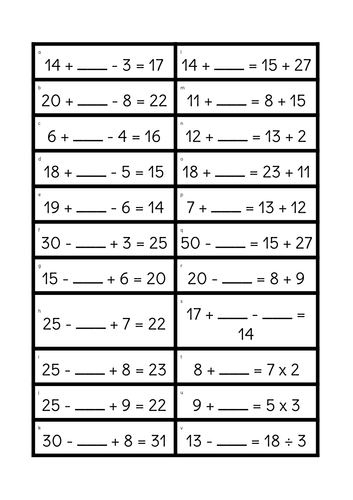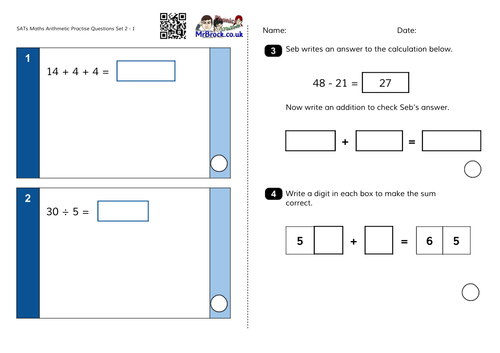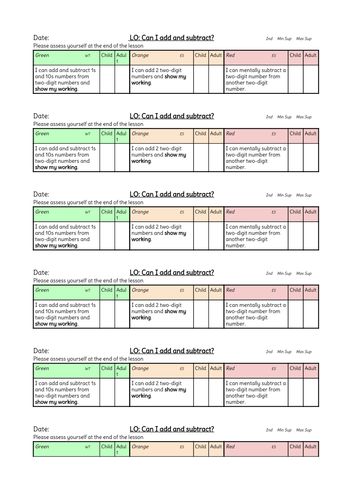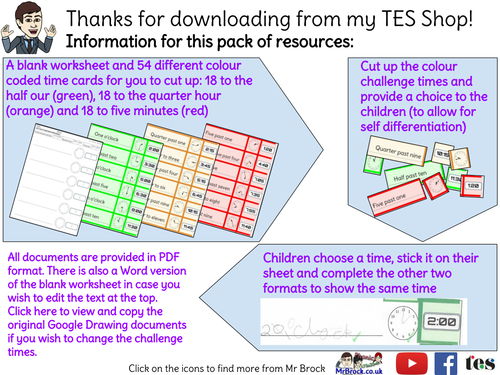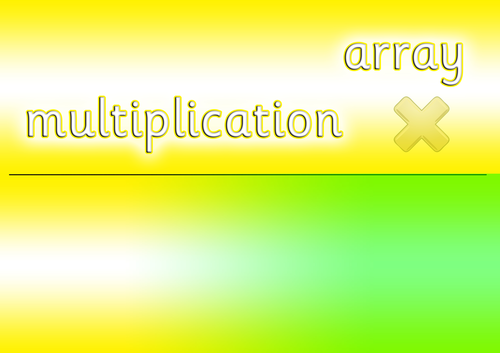
17Uploads
261k+Views
226k+Downloads
Mathematics

KS1 Year 2 Maths Reasoning Worded Problems - Multiplication, Division, Addition and Subtraction
A group of six sets of differentiated worded maths problems to test reasoning skills that fit with the new national curriculum. The problems are colour coded according to difficulty and each set has been provided in PDF format as well as Word format to allow for easy editing should you wish to amend them to fit your topic. These questions are loosely related to the topic os 'Explorers'.
Personally when I used these in related lessons the children were provided with a choice on their table so they could challenge themselves according to the colour coding. I used the mixed sets to start testing their ability to choose the correct operation.
Includes:
Addition (green - not crossing tens; orange - crossing tens; and red - two step)
Subtraction (green - not crossing tens; orange - crossing tens; and red - two step)
Multiplication (green - 2s and 10s; orange - 5s and 3s; and red - two step)
Division (green - 2s and 10s; orange - 5s and 3s; and red - two step or questions that may involve a remainder)
Two sets of mixed multiplication and division problems.

KS1 Inverse of Addition & Subtraction Evidence Gathering Lesson - Working Towards and Expected
This lesson (stand-alone or could be returned to once or twice) is ideal for gathering evidence to support your teacher assessment for inverse of addition and subtraction related statements on the 2016 KS1 Interim Assessment Framework for Maths.
Including:
A brief 'skeleton' lesson plan, Learning Objective and Success Criteria Assessment slips and 63 colour coded questions.
15 Green questions for the 'Working Towards' statement - "Pupils can use number bonds and related subtraction facts within 20."
24 Orange questions for the 'Expected Standard' statement - "Pupils can recognise the inverse relationships between addition and subtraction..." This task asks them to solve a calculation, write the inverse and check that both calculations 'work'
14 Red questions for the 'Expected Standard' statement - "Pupils can recognise the inverse relationships between addition and subtraction..." this task asks them to solve a calculation then write all the related calculations they know.
With my class I put a selection of question slips on the table appropriate for those particular children. They stick the Learning Objective slip at the top of the page then choose a question, stick in in their book and write their workings and answer next to it.
There are enough questions to ensure you never hear a child saying "I'm finished"

Year 2 Maths Evidence Gathering Activities for all the Greater Depth Statements
A collection of eleven different activities (163 questions in total) to work on and gather evidence for the "Working at Greater Depth" Maths Key Stage One statements. (Please note there is no activity for the 'Reading Scales' statement as that states it should be practical)
22 Complex Missing Number questions (with answers)
26 Determine Remainders from known facts questions
36 Two step worded problems (18 of which are loosely space themed)
6 Reason about addition questions
7 Rewrite addition as simplified multiplication questions
32 Mental addition and Subtraction questions that do involve regrouping / crossing ten
24 Time to 5 minute questions (rewrite the shown time in words - 12 analogue and 12 digital)
4 Compare Shape questions
6 Use Multiplication Facts to Make Deductions

Practise KS1 SATs Questions Maths Arithmetic and Reasoning (similar to the 2016 sample papers)
Maths Arithmetic and Reasoning questions designed to look the same as those in the official 2016 sample paper. 6 sets of papers. Each set includes two papers containing similar questions.
The look, difficulty and style of the questions are as close to the sample paper as I could manage.
Personally I have been giving these to my Year 2 children as SATs preparation and revision. I give them paper 1 which they complete in silence. They then come to the carpet and I go through the ways they could have answered the questions with them. They then go straight back to their tables and do the second paper which has exactly the same types of questions with different numbers and maybe different operations. That way they can put into practise what they have just learnt
There is a video for each set on YouTube aimed at children, that walks through these questions and how to answer them. The video can be found by a QR code on the sheets and the URL is on the last page (so it does not appear on the question sheets you may wish to use in class). We have found that putting the file and link to the video on our school website (on the day they do that set in school) has been appreciated by our parents.
Please note: Set one is available free of charge as a separate resource so you can decide if they are useful.
(If you downloaded this resource before 18th May 2016 you may not have got the whole set so make sure you download the extra pages I have added!)

KS1 Addition: Workshop for parents, Worded problems and Calculation generation poster.
This pack of resources was created for a workshop that Year 2 parents were invited to with their children. The presentation includes the various methods used to teach children addition and gives the children a chance to "show off" in front of their parents whilst allowing the parents a chance to see where their children may need some more practise. Included in this pack is a sheet that includes lots of numbers for children to generate their own calculations (choosing 2 green numbers will not cross tens, and two red numbers will cross the tens). Finally I have also included a set of worded addition problems that are colour coded according to difficulty.
There is a video (https://www.youtube.com/watch?v=I2jBYa3nI3I) that goes through the presentation. Many of our parents were not able to attend the workshop so posting the video on our school website allowed them to complete the workshop at home in their own time.
The presentation includes combining objects, using number lines, equipment, place value, adding using tens and ones graphically, using the column method and finally crossing the tens. The presentation is included in Notebook and Powerpoint formats
The worded problems are provided in PDF and Word format so that you can easily edit them to fit your topic if needed. Please note the same worded problems are also available as a set including subtraction, multiplication and division as a separate paid resource.

KS1 Addition & Subtraction Evidence Gathering Lesson - Working Towards, Expected and Greater Depth
This lesson (stand-alone or could be returned to once or twice) is ideal for gathering evidence to support your teacher assessment of addition and subtraction related statements on the 2016 KS1 Interim Assessment Framework for Maths.
Including:
A brief 'skeleton' lesson plan, Learning Objective and Success Criteria Assessment slips and 102 colour coded questions.
32 Green questions for the 'Working Towards' statement - "Pupils can add and subtract a two-digit number and ones and a two-digit number and tens where no regrouping is required."
32 Orange questions for the 'Expected Standard' statement - "Pupils can add 2 two-digit numbers within 100 and can demonstrate their method."
32 Red questions for the 'Expected Standard' statement - "Pupils can subtract mentally a two-digit number from another two-digit number when there is no regrouping required."
and 6 Black questions for the 'Greater Depth' statement - "Pupils can reason about addition."
With my class I put a selection of question slips on the table appropriate for those particular children. They stick the Learning Objective slip at the top of the page then choose a question, stick in in their book and write their workings and answer next to it.
There are enough questions to ensure you never hear a child saying "I'm finished"
Personally I held the black questions back, only giving them to those children that had shown me enough evidence of the 'Expected Standard' statements.

Greater Than and Less Than KS1 pack: two lessons, interactive game, worksheets and posters
A complete pack for two lessons to introduce, then reinforce using > (greater than), < (less than) and = (equals) to compare.
There is a fun Notebook file for the IWB introducing Alice the Alligator that encourages the children to participate. This lesson compares numbers and amounts of objects. Included in that file is version 1 of the interactive game (also included in the price here as a separate download). The lesson finishes with an 'endless' activity for the children to test their understanding. Plus a 'greater depth' activity that is a two-player game involving place value.
Three posters are included to reinforce the two symbols using the same graphics as the notebook file and game and a poster to explain the two-player dice game.
As a follow-up lesson, later on, there are 4 worksheets (SEN, LA, MA and HA) that also compare calculations and measures. The lower sheets compare simple calculations and numbers, and the higher sheets include conversions, such as mm to cm, and harder calculations.
I have included, as part of the Notebook file, the first version of the interactive game involving Alice, that compares numbers. There are two levels 0-20 and 0-99. This version of the game does not include using =, just < and >. On the intro PDF file there is a link to a folder that includes versions of that game that you can either install on computers in school or add to your school website or learning platform. Versions included in the folder are Flash, .exe and an HTML5 folder (the whole html5 folder can be uploaded to your webspace and accessed via the internet by linking to the index.html file). I am unable to provide technical support for installing and using the game, they are just as an added extra for this resource.
My children have loved playing the two-player dice game as morning work when they arrive first-thing. Parents were grateful that we put a link to the interactive game on the school website so the children could practise at home.

Read and write the time in words, analogue and digital. "Endless" differentiated activity
A great activity that can keep your class busy for as long as you need it to. Ideal as a lesson, after you give your input on telling the time, for the children to practise, or you to assess their knowledge.
If, like me, you hate been followed around the room by children who have 'finished' this is the ideal type of lesson for you. Just have a supply of spare blank worksheets at hand!
There are 18 different times to the half hour (on green), 18 different times to the quarter hour (on orange) and 18 different times to 5 minutes (on red). Children select a time and stick it on their sheet then fill in the other two formats to show the same time as the one they selected. For example, if the choose a digital time they stick it over the blank digital clock on their sheet then complete the analogue clock and write the time in words on the remaining spaces on that line.
I suggest having a choice of different colours on each table so the children can self differentiate (so on my lower ability table, for example, I gave them lots of green cards plus a few orange and one or two red).
Included in this pack is the blank worksheet in PDF and Word (if you want to edit it) formats. Then there are three colour coded sheets of the challenge times that you will need to cut up before the lesson. On the summary PDF I have also added a link to the Google Drive folder where I keep the originals, you can then copy the original files and use Google Drawings if you want to change the times on the challenge cards.

Maths Border with common vocabulary and alternative words and reminders of 2D and 3D shapes.
Bright colourful border ideal for any Maths display. To save space on the display itself the border contains common Maths vocabulary (add, minus, times & divide) alongside the related symbol and related Maths words. There are also reminders of common 2D and 3D shapes.
Stop your border being a waste of space and put it to work for you. Giving you more space for a current up-to-date Maths display.
Please review and share.

KS1 Subtraction: Workshop for parents, Worded problems and Calculation generation poster.
This pack of resources was created for a workshop that Year 2 parents were invited to with their children. The presentation includes the various methods used to teach children subtraction and gives the children a chance to "show off" in front of their parents whilst allowing the parents a chance to see where their children may need some more practise. Included in this pack is a sheet that includes lots of numbers for children to generate their own calculations (choosing a green number to subtract will not cross tens, and a red number will cross the tens). Finally I have also included a set of worded subtraction problems that are colour coded according to difficulty (green-not crossing tens; orange-crossing tens; and red-two step).
There is a video (https://www.youtube.com/watch?v=P9juXCZjjFM) that goes through the presentation. Many of our parents were not able to attend the workshop so posting the video on our school website allowed them to complete the workshop at home in their own time.
The presentation includes using objects, using number lines, equipment, place value, subtracting using tens and ones graphically, using the column method and finally crossing the tens. The presentation is included in Notebook and Powerpoint formats
The worded problems are provided in PDF and Word format so that you can easily edit them to fit your topic if needed. Please note the same worded problems are also available as a set including addition, subtraction and multiplication as a separate paid resource.

KS1 Multiplication: Workshop for parents, Worded problems and Calculation generation poster.
This pack of resources was created for a workshop that Year 2 parents were invited to with their children. The presentation includes the various methods used to teach children multiplication and gives the children a chance to "show off" in front of their parents whilst allowing the parents a chance to see where their children may need some more practise. Included in this pack is a sheet for children to generate their own calculations. Finally I have also included a set of worded multiplication problems that are colour coded according to difficulty (green-twos and tens; orange-threes and fives; and red-two step).
There is a video (https://www.youtube.com/watch?v=CoWwyWVRV1E) that goes through the presentation. Many of our parents were not able to attend the workshop so posting the video on our school website allowed them to complete the workshop at home in their own time.
The presentation includes using objects, arrays and counting skills. The presentation is included in Notebook and Powerpoint formats
The worded problems are provided in PDF and Word format so that you can easily edit them to fit your topic if needed. Please note the same worded problems are also available as a set including addition, subtraction and division as a separate paid resource.

KS1 Division: Workshop for parents, Worded problems and Calculation generation poster.
This pack of resources was created for a workshop that Year 2 parents were invited to with their children. The presentation includes the various methods used to teach children division and gives the children a chance to "show off" in front of their parents whilst allowing the parents a chance to see where their children may need some more practise. Included in this pack is a sheet for children to generate their own calculations. Finally I have also included a set of worded division problems that are colour coded according to difficulty (green-twos and tens; orange-threes and fives; and red-two step).
There is a video (https://www.youtube.com/watch?v=K_3O8mHhQh8) that goes through the presentation. Many of our parents were not able to attend the workshop so posting the video on our school website allowed them to complete the workshop at home in their own time.
The presentation includes using objects, sharing, using jottings and counting skills. The presentation is included in Notebook and Powerpoint formats
The worded problems are provided in PDF and Word format so that you can easily edit them to fit your topic if needed. Please note the same worded problems are also available as a set including addition, subtraction and multiplication as a separate paid resource.

Practise KS1 SATs Questions Maths Arithmetic and Reasoning (similar to the 2016 sample papers)
Maths Arithmetic and Reasoning questions designed to look the same as those in the official 2016 sample paper. 1 set of 2 similar questions.
The look, difficulty and style of the questions are as close to the sample paper as I could manage.
Personally I have been giving these to my Year 2 children as SATs preparation and revision. I give them paper 1 which they complete in silence. They then come to the carpet and I go through the ways they could have answered the questions with them. They then go straight back to their tables and do the second paper which has exactly the same types of questions with different numbers and maybe different operations. That way they can put into practise what they have just learnt
There is a video on YouTube aimed at children, that walks through these questions and how to answer them. The video can be found by a QR code on the sheets and the URL is on the last page (so it does not appear on the question sheets you may wish to use in class). We have found that putting the file and link to the video on our school website (on the day they do that set in school) has been appreciated by our parents.
https://www.youtube.com/watch?v=gvXwQAepELw
This is a free sample. There are six pairs of papers altogether that can be purchased as a premium resource: https://www.tes.com/teaching-resource/practise-ks1-sats-questions-maths-arithmetic-and-reasoning-similar-to-the-2016-sample-papers-11276032
Good luck!



